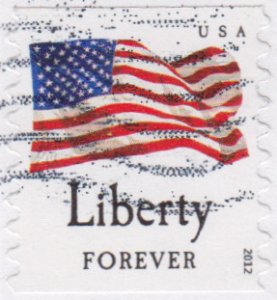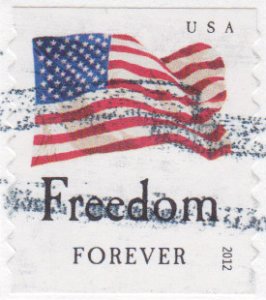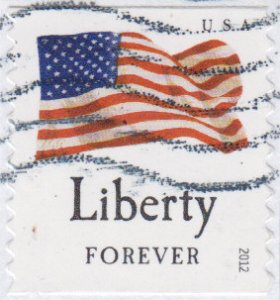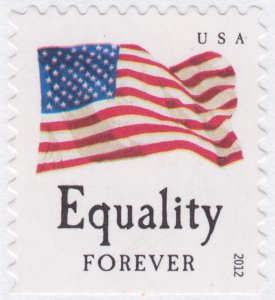How to identify the 2012 Four Flags stamps
If you live in the United States, you’ve no doubt seen quite a few of the Four Flags stamps issued earlier this year. The set features four stamps, each with an identical American flag, but different wording: Freedom, Liberty, Equality, and Justice.
Complicating matters is the fact that each of the three different printers contracted to supply these stamps to the USPS has issued the stamps in two different formats, coil and booklet. 4 designs × 3 printers × 2 varieties per printer = 24 different stamps!
Those who collect only face different stamps don’t have to worry about such things, but for the rest of us, how do we identify which stamp is which? We’ll break down the set here and explain which stamp is which.
Coil stamps
We’ll begin with the coil stamps, as they’re the easiest to identify. Coils of 100 produced by each of the three printers all went on sale on February 22.
First up are the Avery Dennison coils (Scott 4629–4632), which are die cut 8.4 vertically. The big round die cuts make these the easiest to identify.

Next are the Ashton-Potter coils (Scott 4633–4636), which are die cut 9.4 vertically. The die cutting ends 2–3 millimeters from the top and bottom edges of the stamp, which makes this variety appear to have square corners.

Finally, we have the coil stamps printed by Sennett Security Products (Scott 4637–4640), which are die cut 11 vertically.

And that’s it for the coil stamps! As mentioned before, there are four different designs repeated in each coil.
Booklet stamps
The booklet stamps are, unfortunately, a tougher nut to crack. While you should be able to identify each of the coil stamp varieties simply by eyeballing them, each of the booklets has the same gauge of die cutting, which looks like this.

Positive identification therefore requires a millimeter gauge and a magnifying glass—unless you have excellent eyesight, of course.
The first two booklet varieties, printed by Ashton-Potter and Sennett Security Products, were also issued on February 22 in booklets of 20. There are apparently numerous minor differences, but the sure way to distinguish these is size. The Ashton-Potter stamps (Scott 4641–4644) are slightly narrower than the Sennett stamps (Scott 4645–4648). The Ashton-Potter booklet singles measure 18½ mm from the lower left corner to the lower right corner of the flag, while the Sennett stamps measure 19 mm from corner to corner. In this case, size does matter.

Notice the microprinted “USPS” pointed out by the blue arrow in the above illustration? Both the Ashton-Potter and Sennett booklet stamps have this microprinting, but it will help us identify the third booklet variety, those printed by Avery Dennison.
The booklet stamps printed by Avery Dennison (Scott 4673–4676) were not issued until June 1, and were produced as booklets of 10. As pointed out by the blue arrow in the illustration below, the Avery Dennison stamps use a much larger but less bold microprinting than the other two booklet stamps.

And that’s it! For now, that is. According to the Virtual Stamp Club, the USPS has already announced that booklets of 18 printed by Ashton-Potter will be made available starting on September 14. If stamps from that booklet differ from the earlier Ashton-Potter booklet stamps, we’ll be up to 28 different varieties from just four basic designs! As it currently stands, however, we’re at just two dozen.
Published 2012-08-16
Comments
David Wood (2012-08-19 15:06):
Why does USPS use so many variations of this same stamp, it is way too costly for my liking. you can reply to me
Kevin Blackston (2012-08-19 20:39):
The variations seem to be a result of the USPS using multiple printers to produce definitive issues. It seems like it would be cheaper for one printer to do the entire job unless there’s no one company that can produce definitive stamps in the quantities needed. Seems unlikely, but you never know. As it is, the variations are the only obvious indicators of which printer created each stamp, much like with the “secret marks” on the banknote issues of the 1870s.
Sid (2018-12-06 14:12):
Come on gang. Where are the differences between 4641-4644 and 4706-4709?
Kevin Blackston (2018-12-16 21:06):
As you may have noticed, I originally wrote this post prior to Scott 4706–4709 being issued. Those stamps were printed on thin paper with a shiny surface; other than that, they’re identical to the other Ashton-Potter booklet stamps (Scott 4641–4644). My personal opinion is that they’re not sufficiently different to justify distinct major catalogue numbers, but the catalogue editors decided differently.
Log in or leave an anonymous comment.